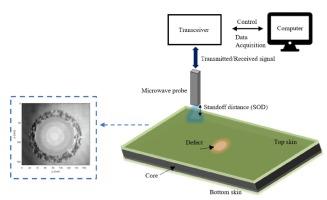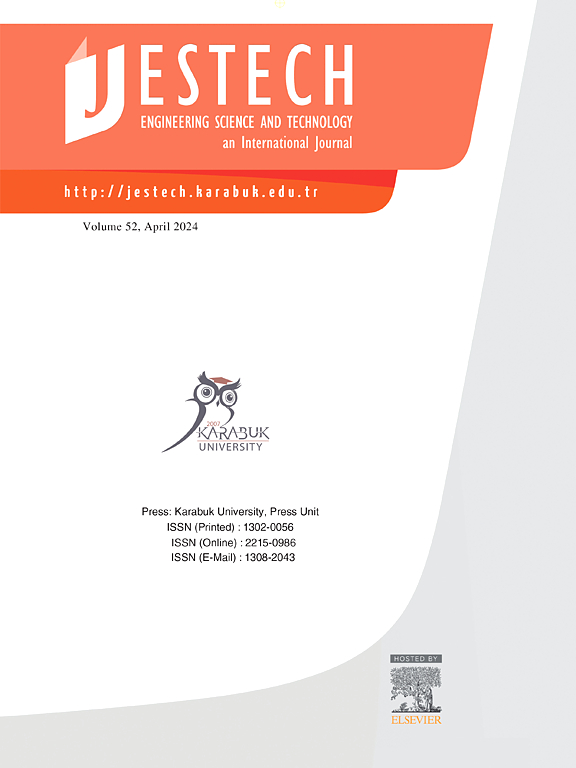复合材料微波无损检测(NDT)综述
IF 5.1
2区 工程技术
Q1 ENGINEERING, MULTIDISCIPLINARY
Engineering Science and Technology-An International Journal-Jestech
Pub Date : 2024-10-01
DOI:10.1016/j.jestch.2024.101848
引用次数: 0
摘要
介电复合材料广泛应用于各行各业。复合材料具有抗腐蚀、重量轻、强度高的固有特性,因此可以无缝集成到石油和天然气、航空航天、能源、运输和国防领域的关键应用中。虽然在某些应用中,复合材料比金属材料更具优势,但复合材料也存在缺陷,这些缺陷可能会破坏复合材料的结构完整性。由于在运行和制造过程中容易出现许多缺陷和异常,因此对复合材料进行例行检查和定期健康监测至关重要。各种无损检测(NDT)技术已成功应用于复合材料检测。然而,大多数模式在可靠检测和定位厚电介质复合材料的缺陷/瑕疵方面成效有限。在为数不多的成功技术中,微波无损检测已多次显示出检测此类复合材料表面/次表面缺陷的潜力。虽然文献中对其他无损检测技术进行了详尽的综述,但对微波无损检测技术的介绍还不够全面。本文综述了用于检测各种复合材料的各种微波无损检测方法。重点介绍了微波探头在可靠检测复合材料中不同类型缺陷方面的作用。为了方便读者直观地了解过去十年中基于微波的无损检测方法的进展情况,本文以表格的形式简要概述了用于检测复合材料中各种缺陷的微波技术的有效性。本文章由计算机程序翻译,如有差异,请以英文原文为准。

A review on microwave non-destructive testing (NDT) of composites
Dielectric composite materials are ubiquitously used across a wide variety of industries. Inherent features encompassing immunity against corrosion, light weight and reasonable strength have allowed composites to be seamlessly integrated within critical applications in the oil and gas, aerospace, energy, transportation and defense sectors. While composites are advantageous to their metal counterparts in certain applications, they are not free from vulnerabilities to defects which could potentially compromise their structural integrity. Being prone to numerous flaws and anomalies during operation and manufacturing, routine inspections and periodic health monitoring of composites is of paramount importance. Various non-destructive testing (NDT) techniques have successfully been applied for composite inspection. However, most modalities have had limited success in reliably detecting and localizing flaws/defects in thick dielectric composites. Among the few successful techniques, microwave NDT has repeatedly shown potential for detection of surface/sub-surface defects in such composites. While other NDT techniques have been thoroughly reviewed in the literature, microwave NDT has not been substantially covered. In this paper, a review of various microwave NDT approaches towards the inspection of various composites is presented. The utility of microwave based probes to reliably detect different types of flaws in composites is highlighted. A succinct overview of effectiveness of microwave techniques used to detect a variety of defects in composites is represented in tabular form for convenience of readers to visualize the progress of microwave based NDT methods in the past decade.
求助全文
通过发布文献求助,成功后即可免费获取论文全文。
去求助
来源期刊

Engineering Science and Technology-An International Journal-Jestech
Materials Science-Electronic, Optical and Magnetic Materials
CiteScore
11.20
自引率
3.50%
发文量
153
审稿时长
22 days
期刊介绍:
Engineering Science and Technology, an International Journal (JESTECH) (formerly Technology), a peer-reviewed quarterly engineering journal, publishes both theoretical and experimental high quality papers of permanent interest, not previously published in journals, in the field of engineering and applied science which aims to promote the theory and practice of technology and engineering. In addition to peer-reviewed original research papers, the Editorial Board welcomes original research reports, state-of-the-art reviews and communications in the broadly defined field of engineering science and technology.
The scope of JESTECH includes a wide spectrum of subjects including:
-Electrical/Electronics and Computer Engineering (Biomedical Engineering and Instrumentation; Coding, Cryptography, and Information Protection; Communications, Networks, Mobile Computing and Distributed Systems; Compilers and Operating Systems; Computer Architecture, Parallel Processing, and Dependability; Computer Vision and Robotics; Control Theory; Electromagnetic Waves, Microwave Techniques and Antennas; Embedded Systems; Integrated Circuits, VLSI Design, Testing, and CAD; Microelectromechanical Systems; Microelectronics, and Electronic Devices and Circuits; Power, Energy and Energy Conversion Systems; Signal, Image, and Speech Processing)
-Mechanical and Civil Engineering (Automotive Technologies; Biomechanics; Construction Materials; Design and Manufacturing; Dynamics and Control; Energy Generation, Utilization, Conversion, and Storage; Fluid Mechanics and Hydraulics; Heat and Mass Transfer; Micro-Nano Sciences; Renewable and Sustainable Energy Technologies; Robotics and Mechatronics; Solid Mechanics and Structure; Thermal Sciences)
-Metallurgical and Materials Engineering (Advanced Materials Science; Biomaterials; Ceramic and Inorgnanic Materials; Electronic-Magnetic Materials; Energy and Environment; Materials Characterizastion; Metallurgy; Polymers and Nanocomposites)
 求助内容:
求助内容: 应助结果提醒方式:
应助结果提醒方式:


